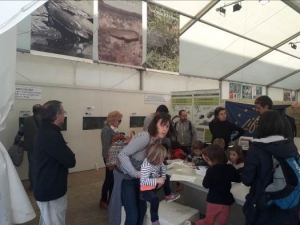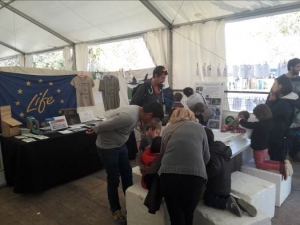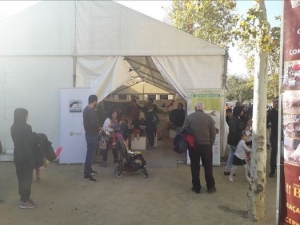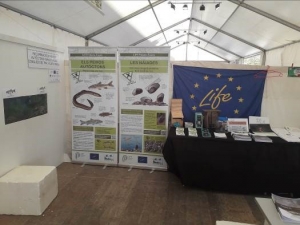Fishes, naiads and storks are the main protagonists of the LIFE Potamo Fauna exhibition at the Fira de Sant Martirià de Banyoles
• One more year the Consorci de l'Estany takes advantage of the fair to carry out an exhibition to raise awareness of the importance of native fauna of the Estany de Banyoles and in the rivers Ter, Fluvià and Muga. • 30,000 people visit the fair according to the organizers, thanks to the good weather of the weekend, also noting that on Friday there were more than 900 students. • Sensitive species are exposed from the LIFE Potamo Fauna project, such as naiads and native fishes, as well as a specific area dedicated to the white stork, a species that is increasingly common in the region.
The Consorci de l’Estany, in collaboration with Limnos was present on the 17th, 18th and 19th of November 2017 at the Fira de Sant Martirià de Banyoles to inform about the LIFE Potamo Fauna project and the natural values of the Estany de Banyoles natural area. In this edition, specifically, protected species such as native fish and naiads where the main actors, to explain the problems of invasive fish and the status of the white stork population in the region.
A 10 meter long and 5 meter wide booth was installed in the area of the “Mostra de Races Autòctones” area, at the Parc de la Draga. Three 100-liter aquariums also joined the booth, with an exhibit wood panel where native fish (barbel, Catalana chub and river blenny) and naiads (elongated naiad) and invasive fish (sunfish, bleak, gambusia, carp). These species have been managed to promote its conservation and breeding in captivity in order to recover their populations both in the Estany de Banyoles, as well as in the River Ter and Fluvià. Also, 4 panels of the exhibition of the LIFE Potamo Fauna project, which referred to fish, naiads and invasive fish, could be seen.
2017 has been a particularly interesting year for the population of the white stork. In addition to the pair breeding in Banyoles, which had three young birds, hundreds of migratory storks have been seen between August and September, and a group of 30 to 60 individuals have been wintering during the October and November months.
During the fair, more than 800 drawings related to wetland’s fauna were distributed, and information about the Potamo Fauna project was offered, as well as the environmental voluntary work of the Limnos association, an NGO that also makes possible the participation of the LIFE project in this Fair.




















